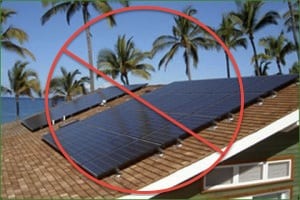To put it mildly, utilities are not generally excited about the rapid uptake of solar PV – or any other form of self-generation or investment in energy efficiency. Their livelihood in most places depends on selling more kilowatt hours, so anything that reduces volumetric sales is frowned upon – whether publicly acknowledged or not. There may be a few exceptions, of course.
A case in point – albeit not a typical one – is the recent decision by the Hawaiian Electric Company (HECO) banning all new solar PV installations on its distribution network. The company’s official reason, as reported by Bloomberg’s Mark Chediak, Christopher Martin and Ken Wells (25 Dec 2013), is that “ … so many Hawaiians are stampeding to solar that (distribution) circuits may become over-saturated, causing voltage spikes, damaging appliances, electronics and even the utility’s equipment.”
HECO has announced it “needs more time to study the matter,” but doesn’t say how long it will take to study. In the meantime, anyone who has or is installing new solar PVs cannot connect to the grid or receive any credit for what is being generated on site.
No doubt, HECO’s distribution circuits are getting overloaded – as are the circuits on Energex in Queensland, Australia – yet homeowners who have installed solar PV are impatient and suspicious of the utility’s motives. With retail tariffs averaging 40 cents/kWh in Hawaii, a typical 1,600 sq. ft. home’s monthly electric bill can easily exceed $400.
HECO’s problems, no doubt, are real. According to the Bloomberg article, 9% of the utility’s residential customers on Oahu, the most populous island, are already generating most of their power from rooftop solar PV while the number of new connections have doubled every year since 2008.
But Hawaii is not alone. The rapid uptake of solar PV is reaching epidemic proportions in California. Arizona, Colorado, Massachusetts and New Jersey, to name a few (Box below). In California, where solar already powers the equivalent of 626,000 homes, according to a Bloomberg article, utilities are pushing for fixed grid connection fees that would add about $120 a year to every consumers’ bills regardless of whether you have solar PVs or not, as reported in the Oct 2013 issue of this newsletter.
Trying to calm the angry solar customers, HECO’s CEO Richard Rosenblum explained the company is “working really hard” to find a solution to oversaturated circuits caused by the rapid solar rollout, promising that the engineering studies will be completed by March 2014. He said, unconvincingly, “We see ourselves as a trailblazer, and one of the problems of being a trailblazer is sometimes the trail is not clear.’’
In the meantime, customers who have invested in solar panels are paying monthly financing fees to the installers plus the utility’s big bills. Naturally they are skeptical of HECO’s official line. Cynthia Thielen, a Republican state legislator, is among the skeptics.
She said, “This is a company with a drenched-in-oil mentality,” adding, “They’ve fought from day one on renewables. I look at the company as ultimately becoming obsolete unless it changes its practices.” For our international readers, Republicans politicians generally tend to be business-friendly. The Bloomberg article says customers are frustrated and skeptical, “They see the company as dragging its feet in an effort to stave off a threat to its very business model,” it notes.
HECO’s worst nemesis, however, may turn out to be storage – batteries, electrical vehicles or whatever can store the excess PV generation during sunny hours for later use.
“Battery storage is the holy grail of the off-the-grid crowd,” according to the Bloomberg article.
Ironically, HECO’s moratorium on solar PV connections, expected to last as long as two years on parts of the solar-saturated network, may drive many customers to install batteries and go off-grid entirely. If storage makes sense anywhere, it would be in sunny Hawaii with its high retail tariffs.
According to a recent radio talk show, HECO’s solar moratorium might have unwittingly let the genie out of the bottle.
Perry Sioshansi is a specialist in electricity sector restructuring, and he has been actively involved in discussions in a number of developed, developing and transition economies. He is founder and president of Menlo Energy Economics is the editor and publisher of EEnergy Informer. He may be reached at [email protected].









